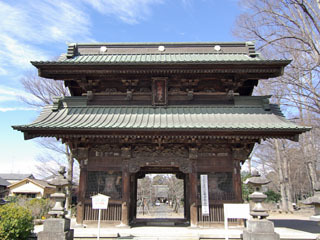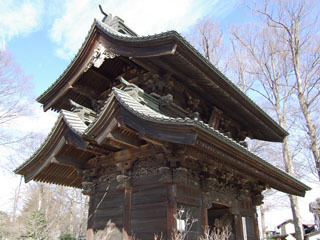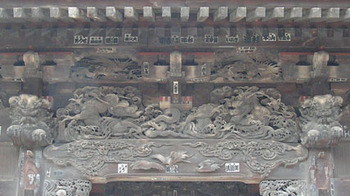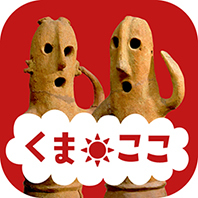令和3年度「地域観光資源の多言語解説整備支援事業」ー妻沼聖天山歓喜院貴惣門ー [その他]
Kisomon Gate
貴惣門

The large and intricately decorated Kisomon Gate is the main entrance to Menuma Shodenzan Temple. It was constructed in 1851 and is the first of three gates that visitors pass through. The wooden gate is over 13 meters tall and supported by eight pillars. The two-tiered roof is distinguished by the unusual feature of three overlapping gables, which protect the carvings beneath from wind and rain.

Masterful carvings and ancient stories
Detailed, three-dimensional carvings decorate the eaves and lintels on all sides of the gate. Fearsome dragons—each with a distinctive facial expression—break through waves on the east and west sides, and lions frolic among peonies on the north and south sides. The pairing of lions and peonies was a common motif in art of the Edo period (1603–1867) and is derived from a Buddhist teaching that warns of the dangers coming from inside ourselves. Even the powerful lion is susceptible to tiny parasites, and it was thought that the dew of the peony could protect the lion by killing these parasites, much as the Buddha offers protection.

Protecting the temple
On either side of the gate, there is a statue of one of the Four Heavenly Kings, guardians of the cardinal directions. On the left is Jikokuten, lord of the east and guardian of the nation. On the right is Bishamonten, lord of the north and guardian of Buddhist law. Each fearsome figure is depicted stepping on a demon.
A gate built by the community
The wood carvings on the Kisomon Gate are unpainted, reflecting the economic hardship of the country during the final years of the Edo period which led the ruling Tokugawa shogunate to restrict the use of decorative finishes. The gate was built with donations from the local community, and the names of donors are inscribed on small wooden tablets placed among the carvings. It was constructed by a descendant of master carpenter Hayashi Masakiyo (1678–1753), who supervised construction of the ornately decorated main hall around 100 years earlier. The Kisomon is designated an Important Cultural Property.
※この英語解説文は観光庁の地域観光資源の多言語解説整備支援事業で作成しました。

The large and intricately decorated Kisomon Gate is the main entrance to Menuma Shodenzan Temple. It was constructed in 1851 and is the first of three gates that visitors pass through. The wooden gate is over 13 meters tall and supported by eight pillars. The two-tiered roof is distinguished by the unusual feature of three overlapping gables, which protect the carvings beneath from wind and rain.

Masterful carvings and ancient stories
Detailed, three-dimensional carvings decorate the eaves and lintels on all sides of the gate. Fearsome dragons—each with a distinctive facial expression—break through waves on the east and west sides, and lions frolic among peonies on the north and south sides. The pairing of lions and peonies was a common motif in art of the Edo period (1603–1867) and is derived from a Buddhist teaching that warns of the dangers coming from inside ourselves. Even the powerful lion is susceptible to tiny parasites, and it was thought that the dew of the peony could protect the lion by killing these parasites, much as the Buddha offers protection.

Protecting the temple
On either side of the gate, there is a statue of one of the Four Heavenly Kings, guardians of the cardinal directions. On the left is Jikokuten, lord of the east and guardian of the nation. On the right is Bishamonten, lord of the north and guardian of Buddhist law. Each fearsome figure is depicted stepping on a demon.
A gate built by the community
The wood carvings on the Kisomon Gate are unpainted, reflecting the economic hardship of the country during the final years of the Edo period which led the ruling Tokugawa shogunate to restrict the use of decorative finishes. The gate was built with donations from the local community, and the names of donors are inscribed on small wooden tablets placed among the carvings. It was constructed by a descendant of master carpenter Hayashi Masakiyo (1678–1753), who supervised construction of the ornately decorated main hall around 100 years earlier. The Kisomon is designated an Important Cultural Property.
※この英語解説文は観光庁の地域観光資源の多言語解説整備支援事業で作成しました。






